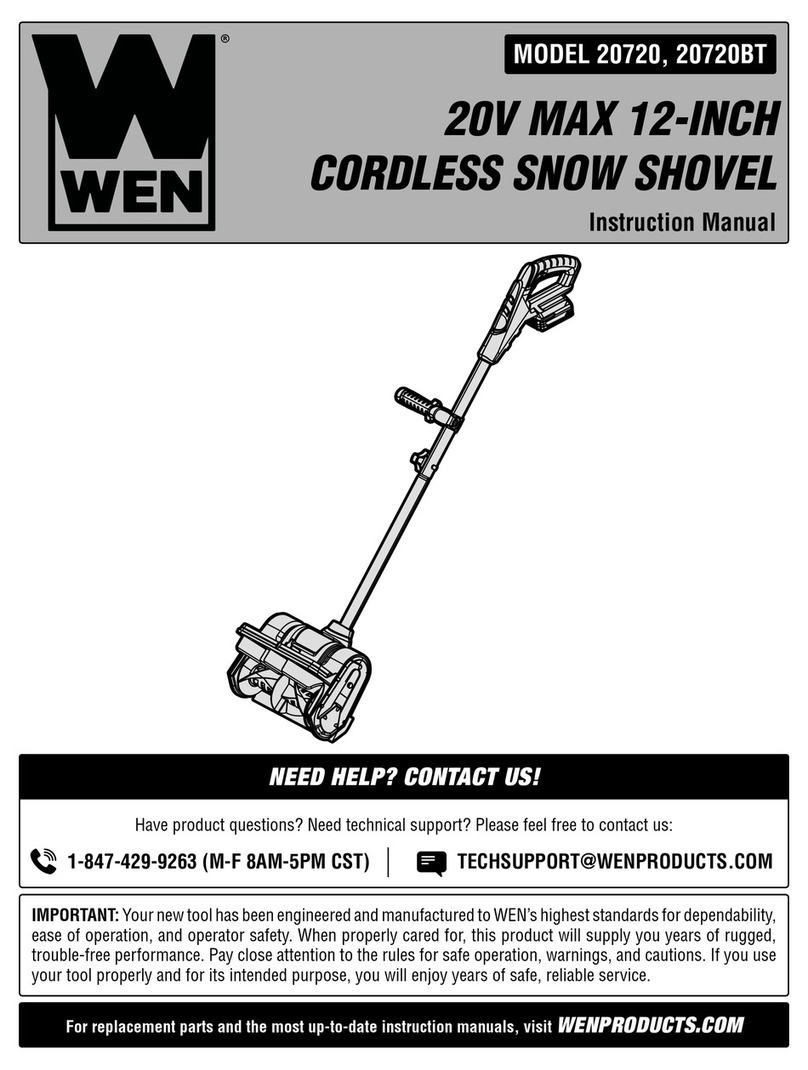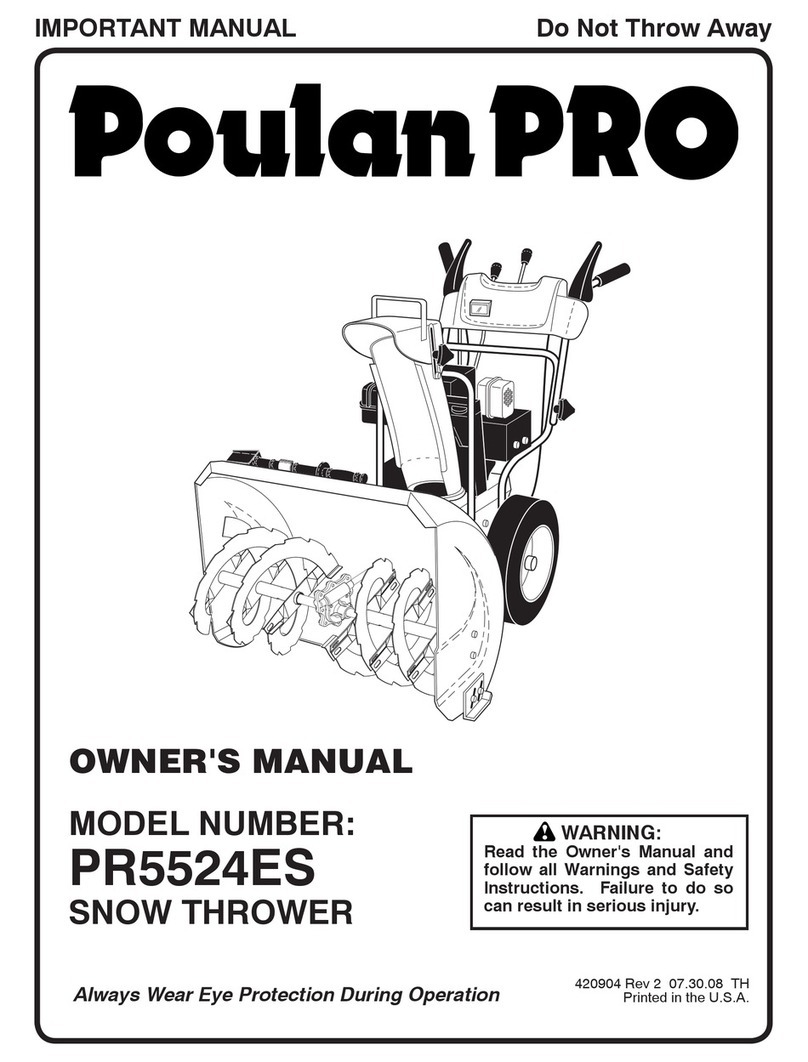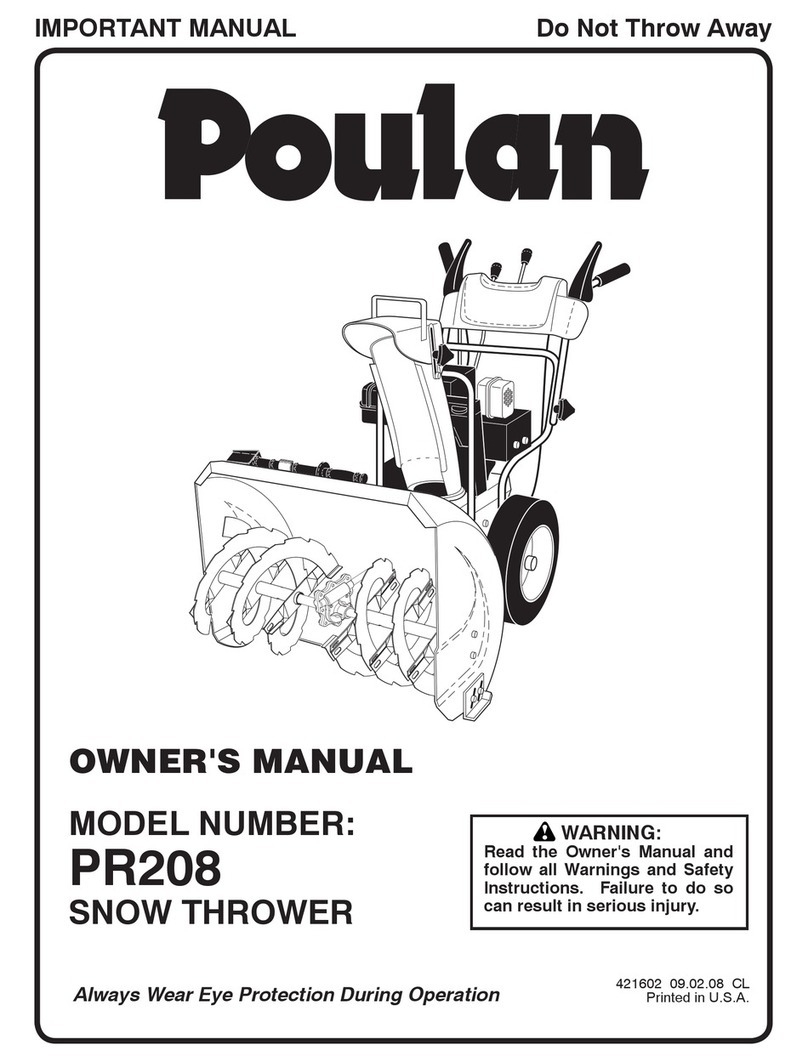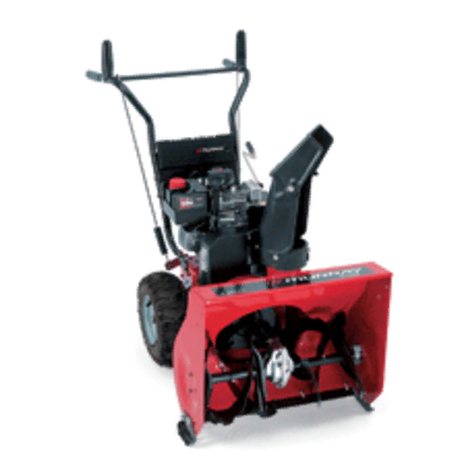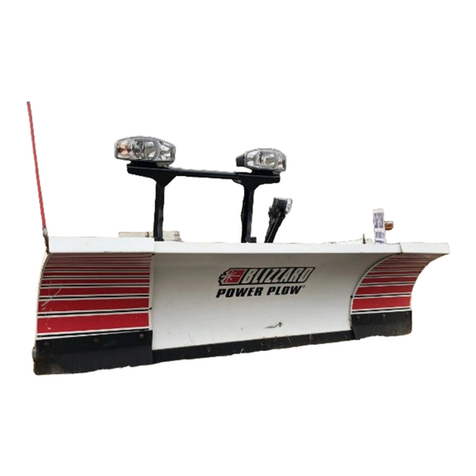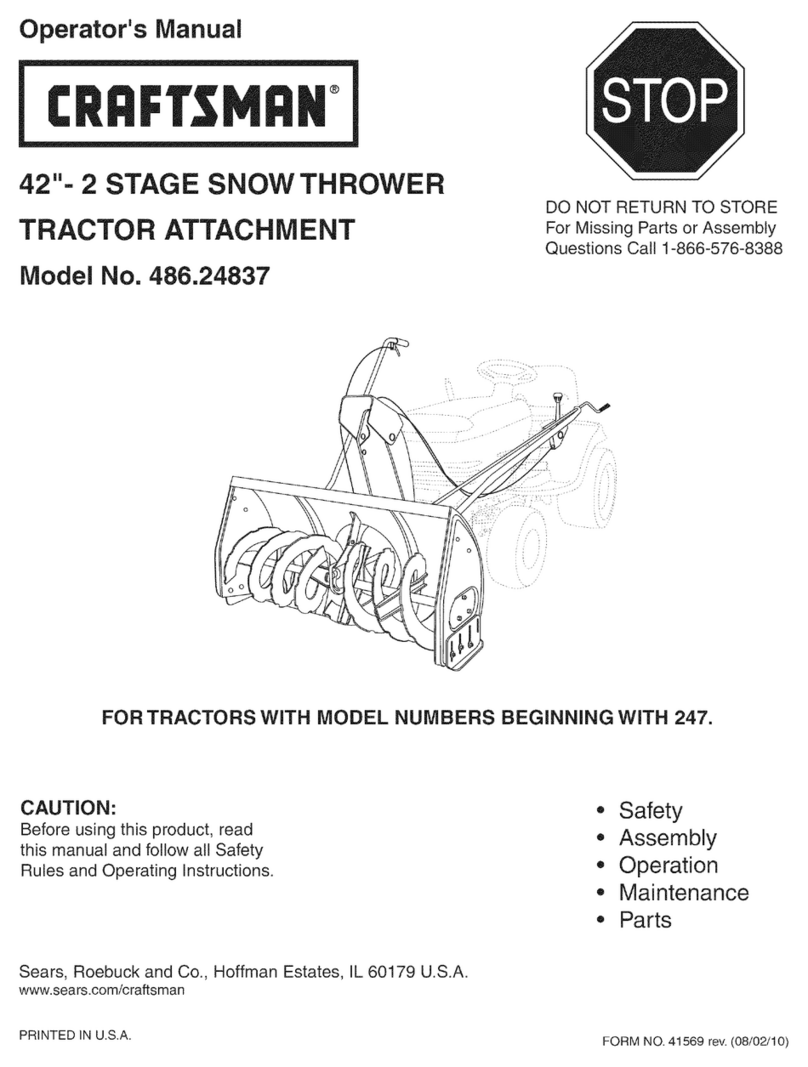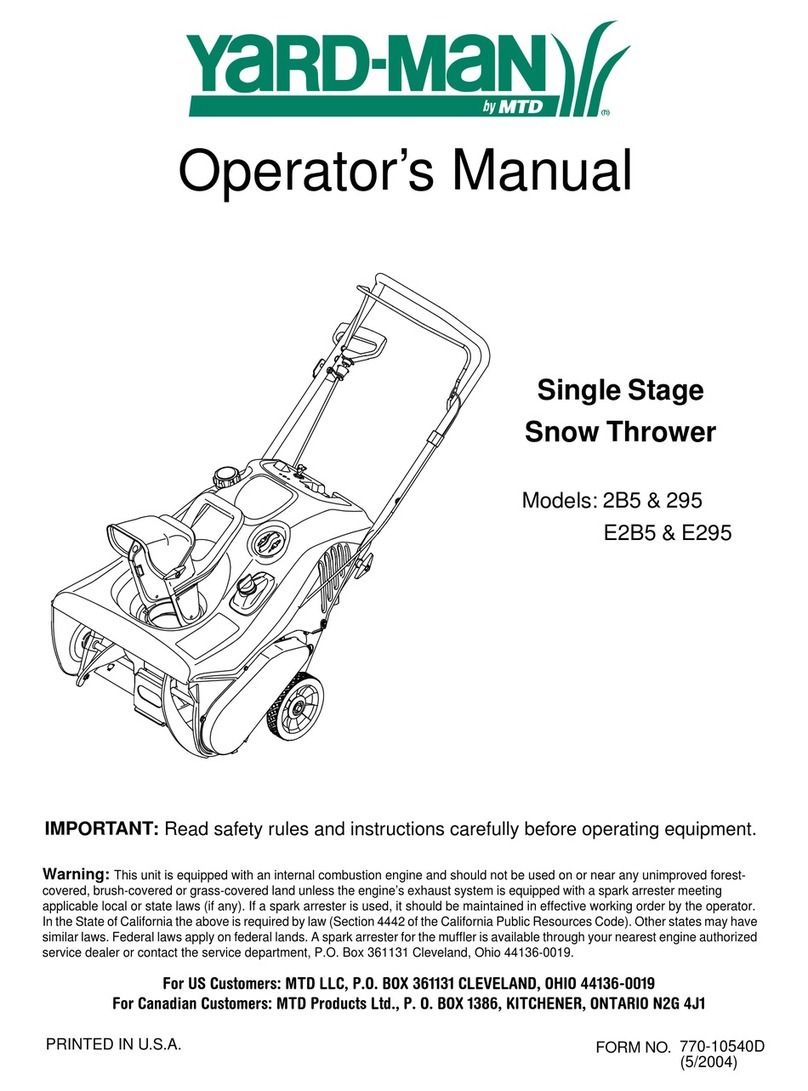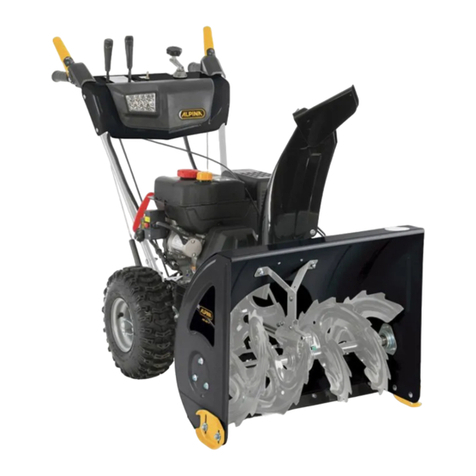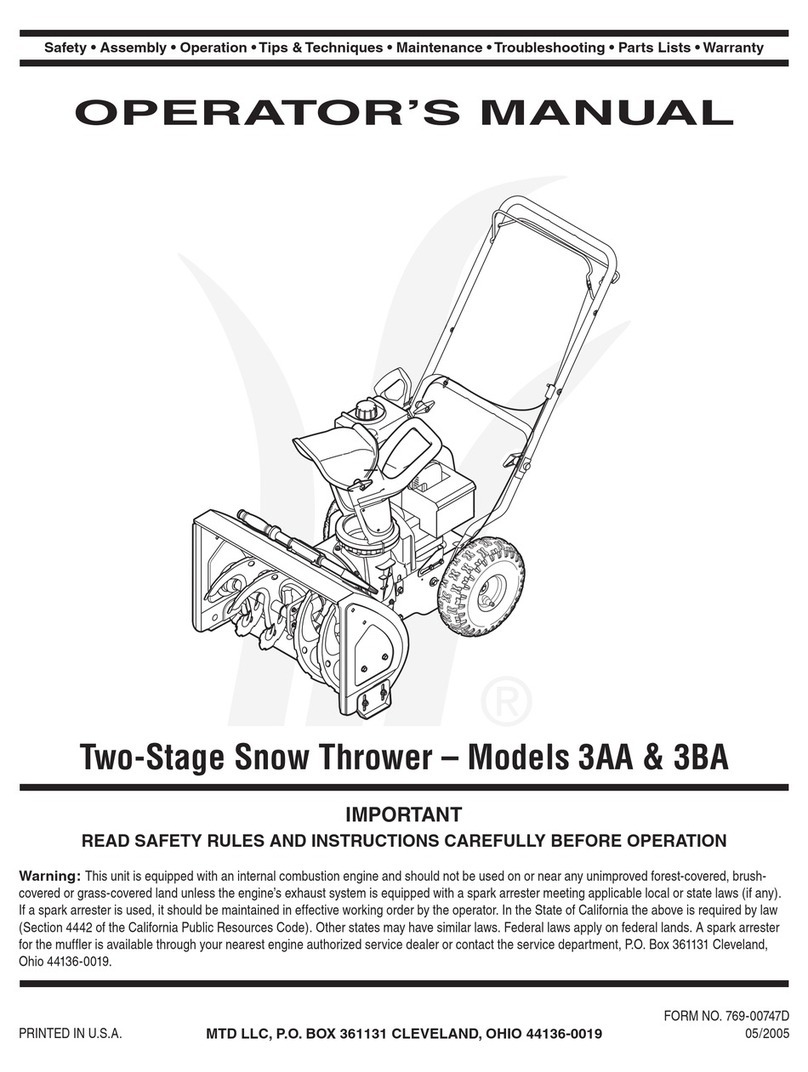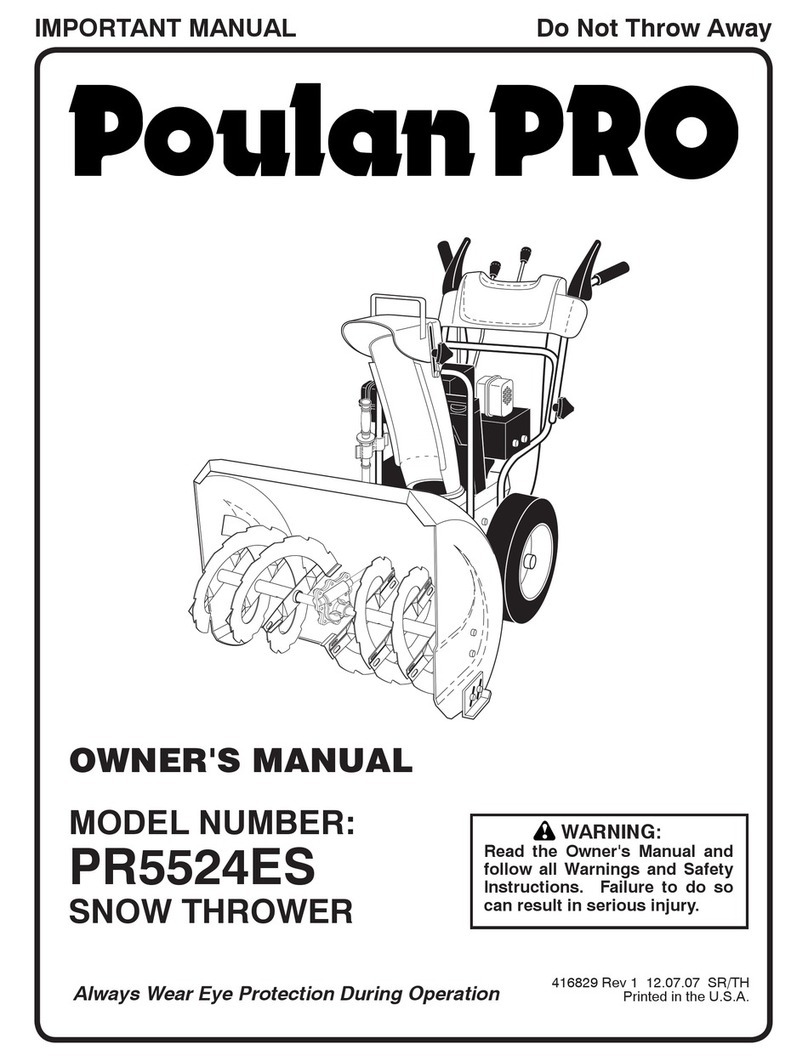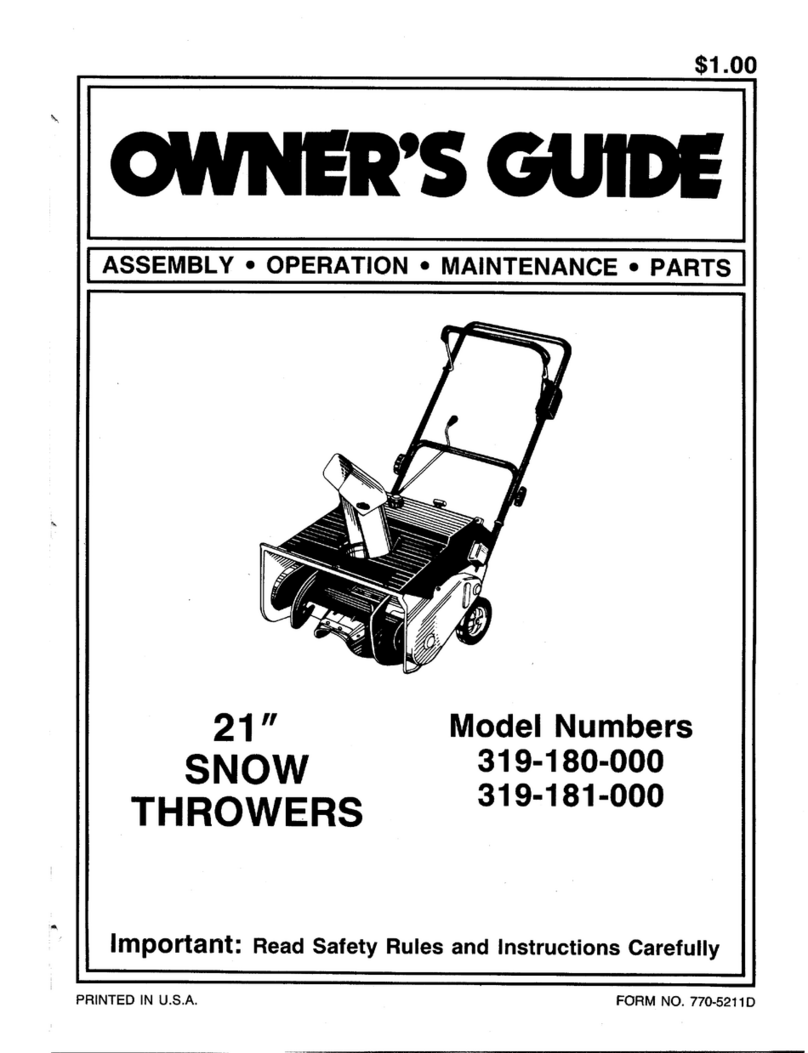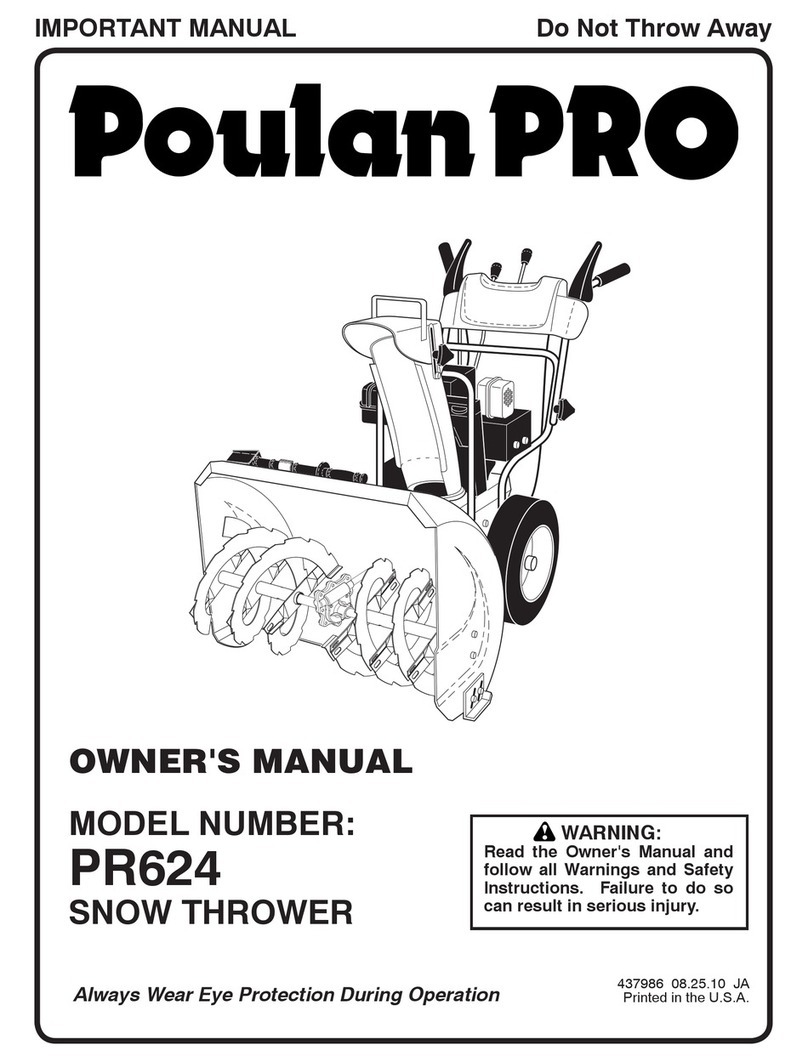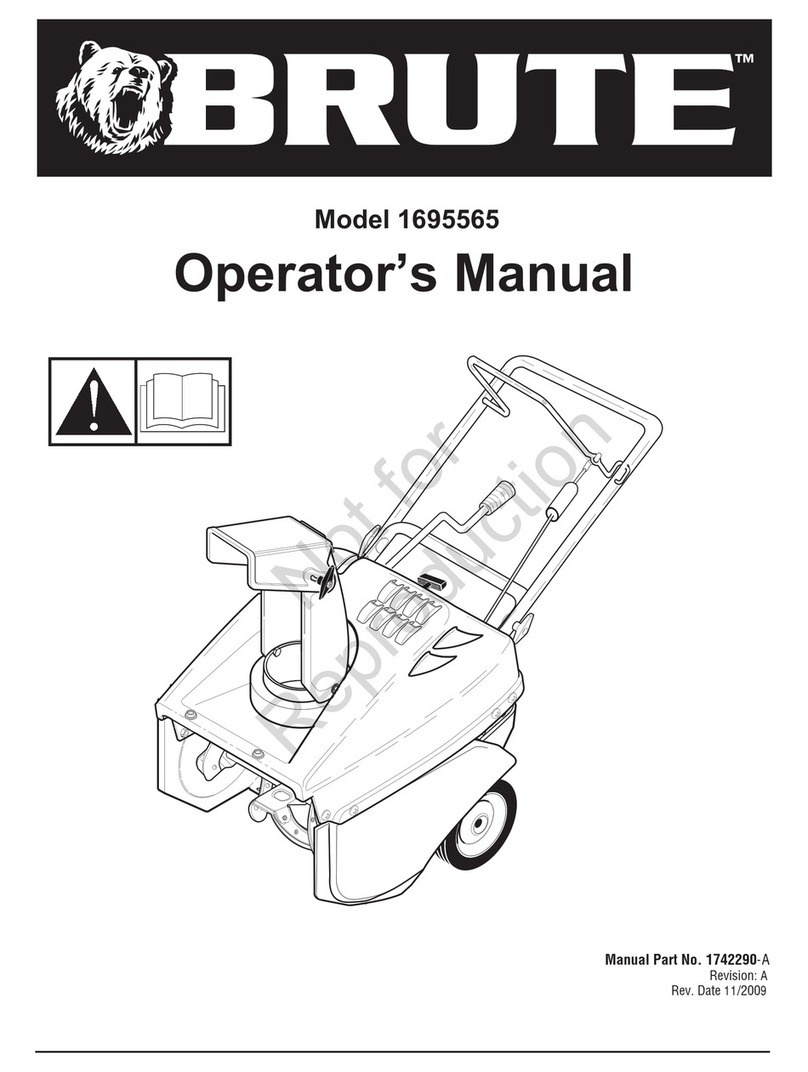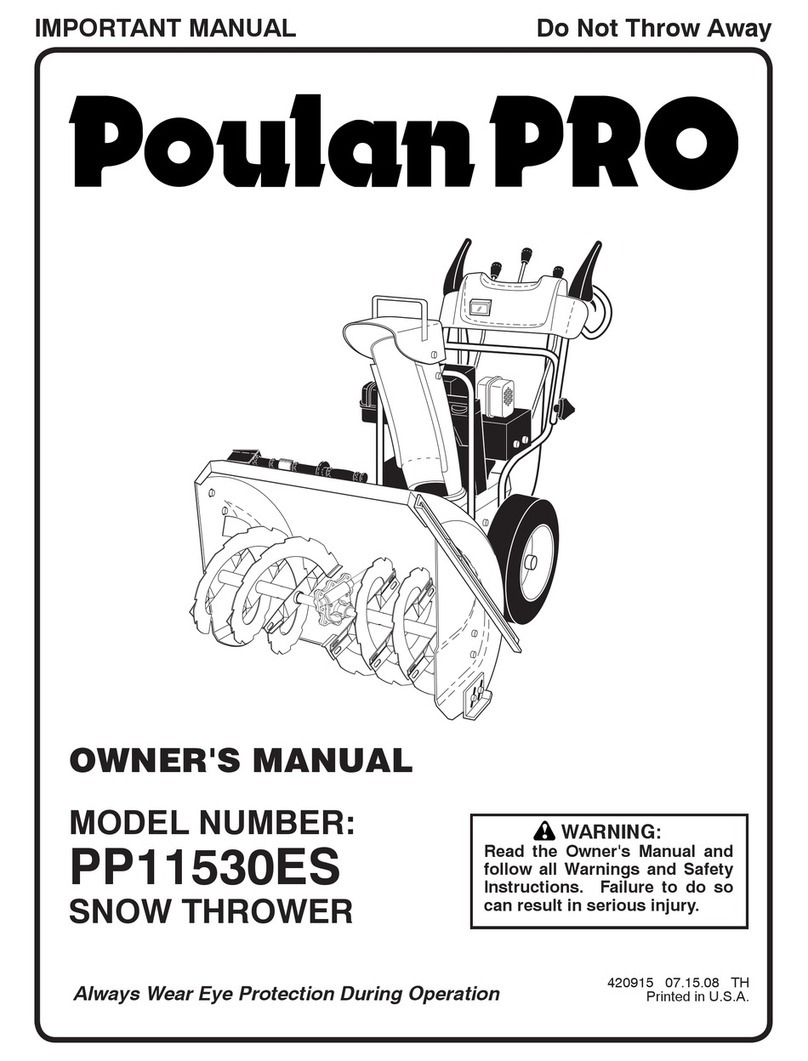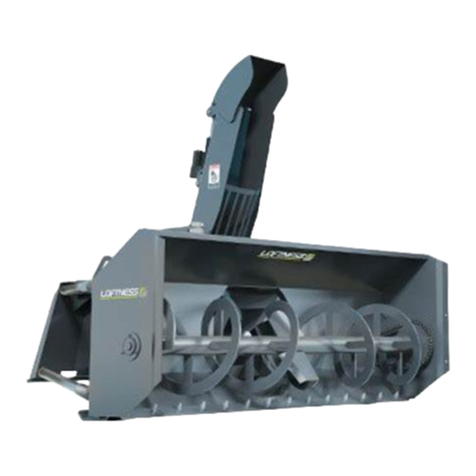Blue Diamond 68 inch User manual

Operation and Maintenance Manual
Extreme Duty
Snow Blower
888-376-7027 | BlueDiamondAttachments.com
Register your
WARRANTY
within 30 days
of purchase
F M: 68”, 72”, & 84”

Blue Diamond® Attachments2
Thank you for your decision to purchase a Blue Dia-
mond® Extreme Duty Snow Blower. To ensure maximum
performance of your equipment, it is mandatory that you
thoroughly study the Operator’s manual and follow the
recommendations. Proper operation and maintenance
are essential to maximize equipment life and prevent
personal injury.
Operate and maintain this equipment in a safe man-
ner and in accordance with all applicable local, state,
and federal codes, regulations and /or laws. Follow all
on-product labeling and instructions.
Make sure that all personnel have read this Operator’s
Manual and thoroughly understand safe and correct
operating, installation and maintenance procedures.
Blue Diamond is continually working to improve its
products. Blue Diamond reserves the right to make any
improvements or changes as deemed practical and pos-
sible without incurring any responsibility or obligation
to make any changes or additions to equipment sold
previously.
Although great care has been taken to ensure the
accuracy of this publication, Blue Diamond makes no
warranty or guarantee of any kind, written or expressed,
implied or otherwise with regard to the information
contained within this manual. Blue Diamond assumes
no responsibility for any errors that may appear in this
manual and shall not be liable under any circumstances
for incidental, consequential or punitive damages in con-
nection with, or arising from the use of this manual.
Keep this manual available for frequent reference. All
new operators or owners must review the manual before
using the equipment and annually thereafter. Contact
your Blue Diamond Attachments Dealer for assistance,
information, or additional copies of the manual. Contact
www.bluediamondattachments.com or call 888-376-
7027 for a complete list of dealers in your area.
Serial Number Location:
Please record attachment information in the space pro-
vided for future reference.
Model Number:_____________________________
Serial Number: _____________________________
Dealer Name: ______________________________
Dealer Number:_____________________________
Date of Purchase:___________________________
The serial number plate is located on the right side of
the frame.
Always use your serial number when requesting infor-
mation or when ordering parts.
NOTE: The directions left, right, front and rear, as
mentioned throughout this manual, are as viewed from
the operator’s position.
Introduction: Owner Information
Revision Date: 11.09.2022

3Blue Diamond® Attachments
Table of Contents
1. Introduction..................................................................................4-5
1.1 Attachment Identification.........................................................4
1.2 Standard Models...................................................................... 5
1.3 Standard Items ......................................................................... 5
1.4 Options....................................................................................... 5
2. Safety ...........................................................................................6-8
2.1 General Safety Information.................................................... 6
2.2 Important Safety Guidelines..................................................7
2.3 Qualified Operator.................................................................. 8
3. Operation ................................................................................. 9-22
3.1 Attachment Inspection............................................................ 9
3.2 Machine Requirements.........................................................10
3.3 Attachment Installation.........................................................12
3.4 Snow Blower Controls ..........................................................15
3.5 Operating the Attachment................................................... 17
4. Maintenance ...........................................................................23-31
4.1 Service Schedule ................................................................... 23
4.2 Cutting Edge Replacement................................................. 24
4.3 Rear Skid Pad Replacement ............................................... 24
4.4 Rear Skid Pad Adjustment .................................................. 24
4.5 Chute Rotation Gear.............................................................25
4.6 Cleaning the Attachment ....................................................26
4.7 Troubleshooting..................................................................... 27
4.8 Hydraulic Manifold................................................................28
4.9 Hose Routing Table ..............................................................29
4.10 Hydraulic Manifold Circuits & Connections ...................30
5. Parts.........................................................................................32-42
5.1 Hydraulic Motor Selection (68”, 72”, & 84”) ..................... 32
5.2 Attachment Control Harness Options.............................. 32
5.3 Main Components (68”, 72”, & 84”) .................................. 33
5.4 Hydraulic Components (11 – 25 GPM).............................. 35
5.5 Hydraulic Components (25 – 35 GPM)............................ 37
5.6 Decal Identification...............................................................39
5.7 Standard Blower Control Harness......................................41
6. Specifications ........................................................................ 43-44
5.1 Attachment Specifications ................................................... 43
5.2 Torque Specifications .......................................................... 44
7. Warranty .........................................................................................41

Blue Diamond® Attachments4
1. Introduction
1.1 Attachment Identification

5Blue Diamond® Attachments
1. Introduction
1.2 Standard Models
68” Snow Blower
72” Snow Blower
84” Snow Blower (Not recommended for machines under 24 GPM)
1.3 Standard Items
• Hydraulic Chute Deflector
• Hydraulic Chute Rotation, 270° (with 7.19” opening)
• Bolt-on Cutting Edge
• Tiger Teeth Augers
• Single auger with 6” center tube and 16” diameter X 1/4” flighting
• 4 bolt auger bearings accommodate 1.5” diameter shaft
• Adjustable rear skid shoes
• Removable QuickAttach Mounting
• Universal Control Harness
• All hydraulic motors (fan motor, enclosed auger motor, chute motor, and deflector cylinder)
• Two-stage Design with 6.5” X 22” 4 Paddle Fan
• Independent Fan and Auger Bypass Relief (no shear pins)
• Powder Coated Paint
1.4 Options
• Various hydraulic packages to match the GPM of most skid steers
• Various electrical harnesses to fit most skid steer models

Blue Diamond® Attachments6
2.1 General Safety Information Operator Training
• Check the rules and regulations at your
location. The rules may include an employer’s
work safety requirements. Regulations may
apply to local driving requirements or use
of a Slow Moving Vehicle (SMV) emblem.
Regulations may identify a hazard such as a
utility line.
• The new operator must start in an area without
bystanders and use all the controls until he or
she can operate the machine safely under all
conditions of the work area.
2. Safety
CAUTION
The signal word CAUTION on the machine and
in the manuals indicates a potentially hazardous
situation which, if not avoided, may result in minor
or moderate injury. It may also be used to alert
against unsafe practices.
WARNING
The signal word WARNING on the machine and
in the manuals indicates a potentially hazardous
situation which, if not avoided, could result in
death or serious injury.
DANGER
The signal word DANGER on the machine and in
the manuals indicates a hazardous situation which,
if not avoided, will result in death or serious injury.
SAFETY ALERT SYMBOL
This SAFETY ALERT SYMBOL identifies important
safety messages on the equipment and in the
owner’s manual. When you see this symbol, be
alert to the possibility of personal injury and
carefully read the message that follows.
IMPORTANT
The signal word IMPORTANT identifies procedures
which must be followed to avoid damage to the
machine.
WARNING
AVOID SERIOUS INJURY OR DEATH
Operators must receive instructions before
operating the machine. Untrained operators can
cause serious injury or death.
For an operator to be qualified, he or she must
not use drugs or alcoholic drinks which impair
alertness or coordination while working. An
operator who is taking prescription drugs must
get medical advice to determine if he or she can
safely operate a machine and the equipment.

7Blue Diamond® Attachments
2
.
2
Important Safety Guidelines
Operating Safety
• Read and follow instructions in this manual
and the machine’s Operator’s Manual before
operating. Operate equipment according to
both manuals.
Figure 1
NOTE: The manual storage container (Item 1)
[Figure 1] is located on the right rear of the snow
blower frame.
• Under no circumstances should young children
be allowed to work with this equipment.
• This equipment is dangerous to persons
unfamiliar with its operation.
• Check for overhead and/or underground lines
before operating equipment (if applicable).
• In addition to the design and configuration
of equipment, hazard control and accident
prevention are dependent upon the
awareness, concern, prudence, and proper
training of personnel involved in the operation,
transport, maintenance, and storage of
equipment.
• Check that the attachment is securely fastened
to the machine.
• Make sure all the machine controls are in
NEUTRAL before starting the machine.
• Operate the equipment only from the
operator’s position.
• When learning to operate the equipment, do it
at a slow rate in an area clear of bystanders.
• DO NOT permit personnel to be in the work
area when operating the equipment.
• The equipment must be used ONLY on
approved machines.
• DO NOT modify the equipment in any way.
Unauthorized modification may impair the
function and/or safety and could aect the life
of the equipment.
• DO NOT make any adjustments or repairs on
the equipment while the machine is running.
• Keep shields and guards in place. Replace if
damaged.
• DO NOT operate equipment in poor visibility
conditions such as fog, darkness, or any
conditions that limit clear visibility less than
300 feet (100 m) in front of and to the sides of
the equipment.
• When conditions make it necessary to slow
ground speed, shift to a lower gear rather
than reducing engine speed. The engine will
maintain rated speed and keep blower running
at optimum speed.
• DO NOT operate in a work area that has
not been inspected for foreign debris and
obstacles.
• Remove any foreign objects and clearly mark
any objects that cannot be removed.
• Wear safety glasses, gloves, hearing
protection, and other protective clothing when
required.
2. Safety
1

Blue Diamond® Attachments8
Fire Prevention Safety
• Flammable debris (leaves, grass, etc) must
be removed regularly. If flammable debris
is allowed to accumulate, it can cause a fire
hazard. Clean often to avoid this accumulation.
• The equipment’s hydraulic motor compartment
must be inspected every day and cleaned
if necessary to prevent fire hazards and
overheating.
• All fuels, most lubricants and some coolant
mixtures are flammable. Flammable fluids that
are leaking or spilled onto hot surfaces or onto
electrical components can cause a fire.
Fire Prevention Safety
• Comply with state and local laws governing
highway safety and movement of machinery on
public roads.
• Check local laws for all highway lighting and
marking requirements.
• Always yield to oncoming trac and move to
the side of the road so any following trac may
pass.
• Never allow riders on either machine or
equipment.
• If transporting the snow blower on a truck or
trailer, make sure the snow blower is properly
secured to the transport vehicle.
Hydraulic System
• Check hydraulic tubes, hoses and fittings for
damage and leakage. Never use open flame
or bare skin to check for leaks. Hydraulic tubes
and hoses must be properly routed and have
adequate support and secure clamps. Tighten
or replace any parts that show leakage
• Always clean fluid spills. Do not use gasoline or
diesel fuel for cleaning parts. Use commercial
nonflammable solvents.
2.3 Qualified Operator
Operating Safety
Operator Training
• Check the rules and regulations at your
location. The rules may include an employer’s
work safety requirements. Regulations may
apply to local driving requirements or use
of a Slow Moving Vehicle (SMV) emblem.
Regulations may identify a hazard such as a
utility line.
• The new operator must start in an area without
bystanders and use all the controls until he or
she can operate the machine safely under all
conditions of the work area.
2. Safety
AVOID SERIOUS INJURY OR DEATH
Operators must receive instructions before
operating the machine. Untrained operators can
cause serious injury or death.
For an operator to be qualified, he or she must
not use drugs or alcoholic drinks which impair
alertness or coordination while working. An
operator who is taking prescription drugs must
get medical advice to determine if he or she can
safely operate a machine and the equipment.
For an operator to be qualified, he or she must
have read and understood the instructions of
this manual, he or she must make adequate
preparation for the proper use of the machine,
and he or she must hold a driving license.
In case of doubt regarding the use of the machine
and/or the interpretation of this manual, the
operator must contact either their dealer or Blue
Diamond.
DANGER

9Blue Diamond® Attachments
3.1 Attachment Inspection
Pre-Operation Inspection
Before operating the Snow Blower for the first time
and each time thereafter, use the following list as a
guideline during equipment inspection.
• Use only a machine of adequate power and
weight to operate the snow blower.
• Fully clean the attachment. (See “Cleaning The
Attachment” on page 26)
• Lubricate the attachment as explained in the
Maintenance Section. See “Grease Points” on
page 23.
• Check the snow blower mounting plate for
wear or damage.
• Check the fan, auger, and cutting edge for
entangled debris, wear or damage.
• Check that all shields and guards are in place.
• Check for loose bolts and tighten them if
necessary.
• Check all welds on the attachment for cracks
each time the attachment is removed from the
machine.
• Check for damaged or missing safety decals.
Replace if necessary.
• Inspect the machine’s mounting frame. (See
the machine’s Operator’s Manual for inspecting
the mounting frame). Replace any parts
that are damaged, bent or missing. Keep all
fasteners tight. Look for cracked welds.
• Check that the chute rotation gear is fully
engaged and not worn. Adjust or repair as
needed before operation.
• Check that all wire harness connections are
secure.
• Check condition of all hydraulic components
for leaks. Repair as required
NOTE: Do not operate with hydraulic leaks.
• Verify that the snow blower is properly
connected to the machine.
3. Operation
WARNING
Leaking fluids under pressure can enter the skin
and cause serious injury or death. Immediate
medical attention is required. Wear goggles. Use
cardboard to check for leaks.
WARNING
AVOID SERIOUS INJURY OR DEATH
• Disengage machine’s auxiliary hydraulics,
engage the machine’s parking brake, stop the
engine and make sure all rotating components
are completely stopped before connecting,
disconnecting, adjusting, or cleaning
equipment.
• Always keep shields and all guards in place
when using the equipment.
• Disengage machine’s auxiliary hydraulics for
road travel.
• Keep hands, feet, and clothing away from
rotating parts.

Blue Diamond® Attachments10
3.1 Attachment Inspection
Cont’d
Daily Inspection
NOTE: Inspect the attachment by performing a
walk around daily before and after use. Use the
following inspection checklist as a guideline.
Check the following items every 10 hours of
operation:
• Verify that the snow blower is properly
connected to the machine.
• Check that all shields and guards are in place.
• Check for damaged or leaking hydraulic hoses
or fittings. Replace if necessary.
• Check the snow blower mounting hardware for
wear or damage. Inspect the pins and mount
(on the attachment) for wear or damage. Repair
or replace damaged parts if necessary.
Weekly Inspection
• Check the following items every 40 hours of
operation:
• Check the cutting edge for wear or damage.
• Inspect the snow blower fan and auger for
cracks, bends, or damage.
• Check the discharge chute and deflector for
wear or damage.
• Check all bolts for tightness.
Monthly Inspection
• Inspect the snow blower frame and all welds
for cracks or damage.
• Check skid plates for wear.
• Check that all bolts are tight.
• Check for damaged or missing decals. Replace
if necessary.
3.2 Machine Requirements
Daily Inspection
This snowblower is for use with small to large skid
steer models and some compact wheel loader
models (Machine). Compact wheel loader must
have low quick-attach mount (skid steer style) and
creep control ability for 0.4 mph minimum ground
speed.
3. Operation
SNOW BLOWER
MODEL
HYDRAULIC
FLOW
LIFT
CAPACITY
68” 11 – 35 GPM 915 lbs
72” 11 – 35 GPM 950 lbs
84” 24 – 35 GPM 1,050 lbs
HYDRAULIC FLOW OPTIONS
Hydraulic Package Skid Steer Requirements
15 11 – 16 GPM
20 17 – 20 GPM
22 21 – 23 GPM
25 24 – 25 GPM
30 25 – 29 GPM
35 30 – 35 GPM

11Blue Diamond® Attachments
IMPORTANT
The snowblower is rated for a specific hydraulic
flow that should match your machine hydraulic
capacity. Operating the snowblower at a higher
than rated flow will over-speed the snow blower
and may cause severe damage to snow blower
components, and will void your product warranty.
Machine Hydraulic Rating
Locate the snow blower hydraulic flow rating decal
(Item 1) [Figure 2)] (more examples in Figure 3) and
ensure that the machine is rated for the required
flow. Set the operator controls to match the rated
flow of the snow blower. Do not operate at flow
setting higher than the rated flow. Do not use a
machine that is not rated for the required snow
blower hydraulic flow.
Figure 2
Figure 3
3. Operation
1

Blue Diamond® Attachments12
3.3 Attachment Installation
Entering The Operator’s Position
Use the attachment safety treads, handles and
steps (on the machine) to enter the operator’s
position.
When in the operator’s position, lower safety seat
bar, start the engine and release the parking brake.
Leaving The Operator’s Position
Park the machine/attachment on a flat level
surface.
Place all controls in neutral, engage the park
brake, stop the engine and wait for all moving
parts to stop. Leave the operator’s position.
Connecting Attachment To The Machine
Before connecting to the attachment, inspect the
machine’s mounting plate. (See the machine’s
Operator’s Manual for inspecting the mounting
frame).
Enter the operator’s position. See “Entering The
Operator’s Position” on page 12.
Drive the machine slowly forward, until the top
edge of the machine’s mounting plate is under the
top flange of the attachment mounting frame.
Slowly tilt the machine’s mounting plate back until
the attachment mounting frame fully contacts the
front of the machine’s mounting plate.
Leave the operator’s position. See “Leaving The
Operator’s Position” on page 12.
3. Operation
WARNING
AVOID SERIOUS INJURY OR DEATH
• Always park on a flat level surface.
• Lower lift arms and place attachment flat on
the ground.
• Place all controls in NEUTRAL.
• Engage the park brake.
• Stop the engine and remove the key.
• Wait for all moving parts to stop.
SEE MACHINE’S OPERATOR’S MANUAL FOR
ADDITIONAL INFORMATION.
IMPORTANT
See the machine’s Operator’s Manual for detailed
information on operating the loader.
WARNING
CRUSH HAZARD
• Before moving the machine, look in all
directions and make sure no bystanders,
especially small children are in the work area.
Do not allow anyone between the machine
and attachment when approaching the
attachment for connecting.
• Keep fingers and hands out of pinch points
when connecting and disconnecting the
attachment.

13Blue Diamond® Attachments
Connecting Attachment To The Machine
Cont’d
Engage attachment locking levers / wedges (See
the machine’s Operator’s Manual for detailed
information).
Connecting Hydraulic Hoses
Remove dirt or debris from the male and female
couplers. Visually inspect the couplers for
corroding, cracking, damage, or excessive wear.
Replace as needed.
Connect the attachment hydraulic hoses to
the machine. Pull on each hose to verify full
connection is made.
Disconnecting Hydraulic Hoses
Relieve auxiliary hydraulic pressure. (See
the machine’s Operator’s Manual for correct
procedure.)
Disconnect attachment hydraulic hoses from the
machine.
Attachment Control Harness
Connecting Attachment Control Harness
Remove storage cap on the machine and
snowblower control harness ends. Route and
connect the snow blower’s attachment control
harness to the machine attachment control
connector bulkhead. Secure harness to route with
existing snowblower hoses.
Disconnecting Attachment Control Harness
Disconnect the snow blower attachment control
harness from the attachment control connector
bulkhead. Replace storage caps on the bulkhead
and snow blower connector ends.
3. Operation
WARNING
AVOID SERIOUS INJURY OR DEATH
The locking pins / wedges must extend through
the holes in the attachment mounting frame.
Failure to secure locking pins / wedges can allow
attachment to come o.
SEE MACHINE’S OPERATOR’S MANUAL FOR
ADDITIONAL INFORMATION.
IMPORTANT
Throughly clean the quick couplers before
making connections. Dirt can quickly damage the
hydraulic system.
WARNING
AVOID BURNS
Hydraulic fluid, tubes, fittings, and quick couplers
can get hot during operation. Be careful when
connecting and disconnecting hydraulic hoses.

Blue Diamond® Attachments14
Disconnecting Attachment From the
Machine
NOTE: Rear skid pads must be fully retracted
before removing the snow blower from the
machine.
Before removing the snow blower from the
machine, fully retract all rear skid pads.
NOTE: Put the snow blower on planks or blocks
before removing the snow blower from the
machine to prevent the snow blower from settling
or sinking in soft/wet ground.
Park the machine and attachment on a flat level
surface. Lower the lift arms and put the snow
blower flat on the ground.
Stop the engine and release auxiliary hydraulic
pressure. (See the machine’s Operator’s Manual
for correct procedure.)
Exit the machine and leave the operator’s position.
See “Leaving The Operator’s Position” on page 12.
Disconnect attachment hydraulic hoses from the
machine.
Disengage locking pins / wedges. (See the
machine’s Operator’s Manual for correct
procedure.)
Disconnect the attachment control harness.
Enter the operator’s position. See “Entering The
Operator’s Position” on page 12.
Slowly tilt the machine’s mounting plate forward
until the attachment mounting frame is free from
the machine’s mounting plate.
Drive the machine slowly backward, away from the
attachment.
3. Operation
WARNING
AVOID SERIOUS INJURY OR DEATH
Before you exit the machine:
• Lower the lift arms, put the attachment flat on
the ground.
• Stop the engine and engage the parking
brake.
• Always keep your feet on the pedals or
footrests and hands on the controls.
• Move all controls until they are LOCKED or in
the NEUTRAL position.
SEE MACHINE’S OPERATOR’S MANUAL FOR
ADDITIONAL INFORMATION.

15Blue Diamond® Attachments
3.4 Snow Blower Controls
Machine Controls
Access the machine control options with either
the side panel (Item 1) [Figure 4] or the secondary
display (Item 1) [Figure 5] to set the machine
operation (as applicable) for optimum performance
as needed. (See machine owners manual for
accessing control options).
Figure 4
Figure 5
Creep Control
Set the minimum ground speed by adjusting Creep
Control to the lowest setting. Adjust Creep Control
higher as needed for conditions and operator
experience. If minimum ground speed setting
is still too fast for operating conditions, use the
brake pedal (as applicable) to additionally slow
the machine ground speed as needed. Consult
your machine dealer for additional creep speed
settings.
Auxiliary Hydraulic Flow
Set the auxiliary hydraulic flow to match snow
blower flow rating of 15 GPM, 20 GPM, 22
GPM, 25 GPM, 30 GPM or 35 GPM. (Refer
to “Machine Hydraulic Rating” page 12 to
determine machine flow requirements).
Auxiliary Function Continuous Flow
Use button to enable or disable continuous
auxiliary hydraulic flow. Must be enabled
prior to engaging machine auxiliary hydraulic
circuit.
Performance Mode
Use button to enable or disable high idle
engine speed. Must be enabled (engine speed
at maximum rpm) on high flow machines (25-
35) for maximum rated hydraulic flow.
Throttle Lock
Use button to activate Throttle Lock and
maintain max engine speed to reduce
operator fatigue.
Speed Range 1
Use Speed Range 1 with Creep Control setting
to reduce operator fatigue. Adjust creep
control higher as needed for conditions and
operator experience.
3. Operation
1
1

Blue Diamond® Attachments16
3.4 Snow Blower Controls
Cont’d
Machine Controls Cont’d
Figure 6
Access the machine joystick control (Item 1) [Figure
6] for the Auxiliary Hydraulic Control button (one
style shown, others are similar).
Activate the snow blower hydraulics by engaging
the machine auxiliary hydraulic circuit (Item 2)
[Figure 6]. Press button forward to engage/
disengage pressure side auxiliary hydraulic line.
(See machine owners manual for using auxiliary
hydraulic controls). Snow blower fan and auger
will run when machine auxiliary hydraulics are
engaged.
With the auxiliary hydraulics engaged, the chute
rotate left/right and deflector up/down functions
can be operated from the machine joystick
controls. Use the LH joystick for chute rotate
functions (Circled Item 3) [Figure 6] and the RH
joystick for deflector functions (Circled Item 4)
[Figure 6]. (See your machine operator manual for
operating the auxiliary control functions).
3. Operation
WARNING
AVOID SERIOUS INJURY OR DEATH
The snow blower fan and auger will run when the
machine auxiliary hydraulics are engaged. Make
certain the working area is clear of obstacles and
bystanders prior to engaging auxiliary hydraulics.
(See machine owners manual for using auxiliary
hydraulic controls.)
1
2
34
IMPORTANT
When engaging or disengaging the snow blower
hydraulics, the machine must be at idle. Hydraulic
motor damage will occur if this procedure is not
followed, voiding warranty.

17Blue Diamond® Attachments
3.5 Operating the Attachment
Checking the Snow Blower Hydraulic
Functions
NOTE: After installing the snow blower, test all
snow blower functions before operating the snow
blower in the work area.
Enter the machine. (See Entering the Operator’s
Position on page 12.)
Start the engine and release the parking brake.
Engage the machine’s auxiliary hydraulics. (See
the machine’s Operation Manual for correct
procedure.)
Raise the engine RPM.
Auger and Fan Rotation
Start auger/fan rotation. Allow the snow
blower auger and fan to rotate for a short time
(approximately one minute).
NOTE: When cold starting, allow hydraulic
temperature to reach a minimum or 60°F.
If operating the snow blower for the first time,
operate the fan and auger at a low speed for a
break-in period of approximately 20 minutes. It
is important to follow this procedure as break-in
period may not have been reached during initial
factory run-out.
Chute Rotation
• Raise the engine RPM.
• Rotate the discharge chute in both directions.
The discharge chute should rotate freely.
Deflector Raise / Lower
• Raise and lower the deflector multiple times.
The deflector should move up and down freely.
Lower engine RPM.
• Disengage the machine’s auxiliary hydraulics.
• Slightly raise the snow blower.
• Exit the machine. (See “Leaving The
• Operator’s Position” on page 13.)
• Adjust rear skid pads to desired height. (See
“Skid Pad Adjustment” on page 24.)
NOTE: All rear skid pads must be set to the
same height.
3. Operation
WARNING
AVOID SERIOUS INJURY OR DEATH
• Never start machine from outside the cab.
• Never operate the machine if any safety
device is damaged, disconnected, or missing.
• Never exit machine with the engine running.
WARNING
AVOID SERIOUS INJURY OR DEATH
While operating the machine:
• Always keep seat belt fastened.
• Safety seat bar lowered (if equipped).
• Always keep your feet on the pedals or
footrests and hands on the controls.
IMPORTANT
It is the operator’s responsibility to know which
machine control operates each function of the
attachment prior to operating the attachment in
the work area.
IMPORTANT
When engaging or disengaging the snow blower
hydraulics, the machine must be at idle. Hydraulic
motor damage will occur if this procedure is not
followed, voiding warranty.
IMPORTANT
The snow blower fan and auger motors require a
break-in period prior to putting the snow blower
into service. Hydraulic motor damage will occur if
this procedure is not followed, voiding warranty.

Blue Diamond® Attachments18
3.5 Operating the Attachment
Cont’d
Final Snow Blower Adjustments
Ensure pressure and return hydraulic lines, and the
snow blower control harness is secured, routed
clear of any loader arm pinch points, and are not
dragging on the ground. Protect hose and harness
from sharp edges on the machine.
Check the machine flow rating on page 11 and
ensure machine settings are correct for proper
hydraulic flow (see “Machine Requirements” on
page 10 for flow range settings).
Set all machine control functions for optimum
performance. (See “Machine Controls” on page 16.)
Move the machine and snow blower to the work
area.
Operation
Move the machine and snow blower to the work
area.
Make sure the skid pads are adjusted to the same
height. (See “Skid Pad Adjustment” on page 24.)
Make certain snow blower setup is correct and
ready for operation. (See “Final Snow Blower
Adjustments” on page 18.)
Enter the machine (See “Entering the Operator’s
Position” on page 12.)
Start the engine and release the parking brake.
Engage the machine’s auxiliary hydraulics. (See
the machine’s Operation Manual for procedure.)
3. Operation
WARNING
AVOID SERIOUS INJURY OR DEATH
Warnings on the machine and in the manuals
are for your safety. Failure to obey warnings can
cause serious injury or death.
WARNING
AVOID SERIOUS INJURY OR DEATH
• Check for overhead power lines and other
overhead obstructions before operating the
snow blower in a raised position.
• Keep the snow blower a minimum of 10 ft.
away from electrical power lines.
WARNING
AVOID SERIOUS INJURY OR DEATH
While operating the machine:
• Always keep seat belt fastened and safety
seat bar lowered (if equipped).
• Make sure that there are no personnel on the
machine or in the area round the machine.
• Engage the park brake.
• Only operate the machine while sitting in the
operator’s position.
• Always keep your feet on the pedals or
footrests and hands on the controls.
• Only operate the controls when the engine is
running.
WARNING
THROWN OBJECTS OR ROTATING BLADES CAN
CAUSE SERIOUS INJURY OR DEATH
• Clear work area of all debris, such as rope,
wire, cable or other materials that can wrap
around auger causing entanglement and
attachment damage.
• Never direct discharge toward bystanders,
buildings, or other property. Debris can be
thrown great distances.

19Blue Diamond® Attachments
Rotate the discharge chute to the desired position.
NOTE: Do not position the discharge chute so
snow is thrown towards bystanders, vehicles,
buildings, livestock, or roadways.
Adjust the deflector to control the distance the
snow is thrown.
NOTE: The distance the snow is thrown is
determined by the density of the snow.
Move the machine engine speed control to high
rpm.
NOTE: Use the Full Flow (auxiliary hydraulics at
100%) and High Performance (full rated engine
RPM) modes on the machine control settings. See
“Machine Controls” on page 16. Ensure that the
machine auxiliary flow controls are set to match
the snowblower flow rating limits, see “Machine
Requirements” on page 10).
Operation Recommendations
Place the machine arms in the float position (if
desired).
Using the tilt function of the machine, position the
snow blower to the desired working position.
Position the snow blower on the cutting edge
when removing snow from paved/finished
surfaces.
NOTE: The machine speed is determined by the
depth and density of the snow.
Work and Travel Speed
Working ground speed will depend upon the depth
and density of the snow. Adjust speed as needed
to clear the work area.
NOTE: A definite pattern of operation is required
to thoroughly clean the work area. The following
patterns will aid the operator and avoid throwing
snow in unwanted areas of the work area.
Left or Right Discharge
Working ground speed will depend upon the depth
and density of the snow. Adjust speed as needed
to clear the work area.
Figure 7
Where it is possible to throw the snow to the left
and right sides of the work area, move the
machine and snow blower to the center of the
work area [Figure 7].
Move the machine and snow blower forward, from
one end to the other, blowing snow to either side
without changing the direction of the discharge
chute [Figure 7].
3. Operation
IMPORTANT
When engaging or disengaging the snow blower
hydraulics, the machine must be at idle. Hydraulic
motor damage will occur if this procedure is not
followed, voiding warranty.
WARNING
AVOID SERIOUS INJURY OR DEATH
Never direct discharge toward bystanders,
buildings or other property. Debris can be thrown
great distances.

Blue Diamond® Attachments20
3.5 Operating the Attachment
Cont’d
Operation Recommendations Cont’d
Single Sided Discharge
Working ground speed will depend upon the depth
and density of the snow. Adjust speed as needed
to clear the work area.
Figure 8
Where snow can only be thrown to one side, move
the machine and snow blower to the opposite end
of the work area, away from the area the snow will
be thrown [Figure 8].
Move the machine and snow blower forward. At
the end of the first path, rotate the discharge chute
180° to maintain the direction the snow needs to
be thrown. Rotate the discharge chute 180° at each
end of the work area until desired amount of snow
has been cleared [Figure 8].
Clearing a Snow Bank
Working ground speed will depend upon the depth
and density of the snow. Adjust speed as needed
to clear the work area.
If snow is deeper than the height of the snow
blower housing, it is necessary to make multiple
passes at dierent heights to clear the snow.
NOTE: Do not attempt to clear snow banks that are
more than 6 ft in height.
Raise the snowblower to the desired height.
Using the tilt function of the machine, position the
snowblower parallel to the ground.
NOTE: Do not make a cut that is deeper than
height of the snow blower housing. Snow that
pushes over the top of the snow blower housing
can cause damage to hydraulic and electrical
components.
Slowly drive forward until the front wheels / tracks
of the machine contact the snow bank.
Back the machine up and adjust the blower to
desired height and repeat procedure until the
snow bank has been cleared or cut to desired
height.
NOTE: Always allow auger and fan to clear of snow
before changing the working height of the snow
blower. Changing the height of the snow blower
by moving the machine lift arms will slow the fan
and auger speeds, which may cause the discharge
chute to plug. (See “Clearing a Plugged Snow
Blower” on page 21.)
3. Operation
IMPORTANT
DO NOT use the snow blower as a push bucket
or push blade. Always have the auger and fan
running when engaged in snow contact.
WARNING
AVOID SERIOUS INJURY OR DEATH
• Check for overhead power lines and other
overhead obstructions before operating the
snow blower in a raised position.
• Keep the snow blower a minimum of 10 ft.
away from electrical power lines.
This manual suits for next models
2
Table of contents
